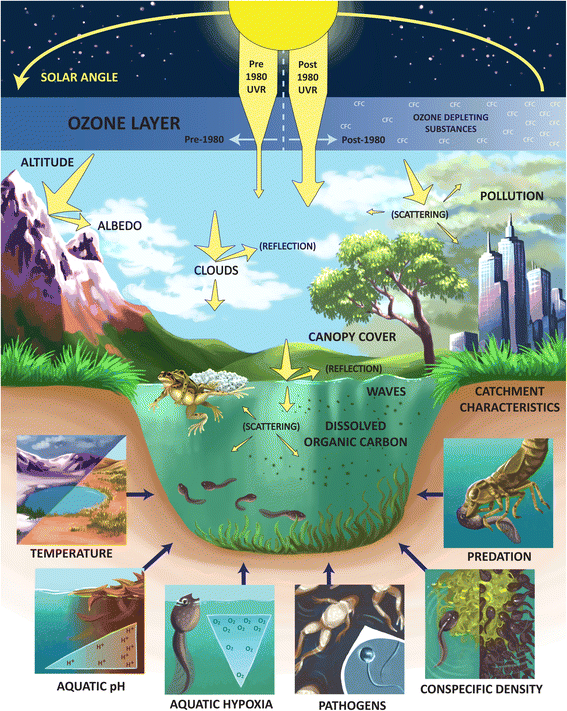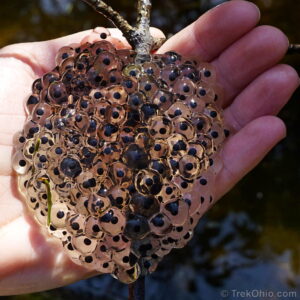Ultraviolet light, or UV light, can harm amphibians. It affects their skin, eyes, and overall health.
Understanding how UV light impacts amphibians is crucial to their conservation. Amphibians, like frogs and salamanders, are sensitive to environmental changes. With the thinning ozone layer, UV radiation levels have risen. This increase poses a threat to amphibians. Their skin absorbs UV light, leading to potential damage.
It can cause DNA mutations, skin burns, and even death. Young amphibians, like tadpoles, are particularly vulnerable. They have thinner skin and spend more time in sunlight. UV light also affects amphibians’ eyes, leading to vision problems. As amphibians are important for ecosystems, their decline could have wide-reaching effects. Understanding these impacts helps in creating better protection strategies for these vital creatures.
Introduction To Ultraviolet Light
Ultraviolet light is a type of electromagnetic radiation. It is invisible to the human eye. The sun is a primary source of ultraviolet light. Understanding ultraviolet light is important. It affects both living and non-living things. Amphibians, for example, can be greatly impacted by ultraviolet light.
Types Of Ultraviolet Light
There are three main types of ultraviolet light. They are UVA, UVB, and UVC. UVA has the longest wavelength. It can penetrate deep into the skin. UVB has a shorter wavelength. It affects the outer layers of the skin. UVC has the shortest wavelength. It is mostly absorbed by the Earth’s atmosphere.
Sources Of Ultraviolet Light
The sun is the main source of ultraviolet light. Artificial sources include tanning beds and black lights. Some welding operations also produce UV light. Even certain types of lasers emit ultraviolet light. Understanding these sources helps us take precautions.

Credit: www.yorku.ca
Amphibians And Their Ecosystems
Amphibians play a crucial role in their ecosystems. They are both predators and prey. They help control insect populations. They also serve as food for many other animals. Amphibians are sensitive to environmental changes. This makes them good indicators of ecosystem health.
Ultraviolet light impacts amphibians in various ways. Understanding these effects is vital. It helps us protect these important creatures. Let’s explore diverse amphibian species and their habitats.
Diverse Amphibian Species
Amphibians include frogs, toads, salamanders, and newts. Each species has unique traits. Frogs have smooth, moist skin. They need water to reproduce. Toads have dry, bumpy skin. They can live farther from water. Salamanders and newts have elongated bodies. They often live in moist environments.
Different species have different needs. Ultraviolet light affects them in specific ways. Some species are more vulnerable than others. Knowing these differences helps in conservation efforts.
Habitats And Environmental Needs
Amphibians live in a variety of habitats. These include ponds, streams, forests, and wetlands. They need clean water and safe breeding grounds. Habitat loss and pollution threaten them. Ultraviolet light adds another risk. It can damage their skin and eyes. It can also affect their eggs.
Some habitats offer natural UV protection. Dense vegetation and shaded areas help. Open areas expose amphibians to more UV light. Understanding habitat needs is crucial. It helps us create safe environments for amphibians.
Protecting their ecosystems ensures their survival. It also maintains the balance of nature. Healthy amphibian populations benefit everyone.
Ultraviolet Light Exposure
Amphibians, such as frogs and salamanders, face various environmental challenges. One significant factor is ultraviolet (UV) light exposure. UV light, especially UVB, can penetrate their delicate skin, affecting their health and survival.
Natural Uv Exposure
Amphibians naturally encounter UV light in their habitats. They bask in sunlight to regulate their body temperature. Yet, this exposure can be harmful. The intensity of UVB varies with altitude, latitude, and season. Higher altitudes and latitudes receive more intense UVB radiation. During breeding seasons, amphibians lay eggs in shallow waters. These eggs are often exposed to high levels of UVB. This can lead to DNA damage and reduced hatching success.
Anthropogenic Uv Sources
Human activities have increased UV exposure for amphibians. Pollution and ozone layer depletion are key factors. Chemicals like CFCs (chlorofluorocarbons) have thinned the ozone layer. This allows more UVB radiation to reach the earth’s surface. Artificial lighting also contributes to UV exposure. Lights near water bodies can disrupt amphibians’ natural behavior. This can lead to increased vulnerability to predators.
| Source of UV Exposure | Impact on Amphibians |
|---|---|
| Natural Sunlight | DNA damage, reduced hatching |
| Ozone Layer Depletion | Increased UVB exposure |
| Artificial Lighting | Behavioral disruption |
Understanding UV exposure helps protect amphibians. Conservation efforts can then focus on mitigating these harmful effects.

Credit: www.sci.news
Physiological Effects On Amphibians
Ultraviolet (UV) light can have serious effects on amphibians. These creatures are especially vulnerable due to their permeable skin and aquatic habitats. Understanding the physiological effects helps us grasp the full impact of UV exposure on amphibian populations.
Skin Damage And Diseases
Amphibians have sensitive skin that absorbs water and oxygen. UV light can cause severe skin damage. It can lead to burns and lesions. This damage makes them more prone to infections and diseases.
In many species, UV exposure reduces the ability to fight off pathogens. This results in higher rates of fungal infections and other skin diseases. In some cases, damaged skin can lead to mortality.
Table displaying effects of UV light on amphibian skin:
| Effect | Result |
|---|---|
| Burns | Lesions and infections |
| Reduced immune response | Higher disease rates |
| Skin damage | Increased mortality |
Impact On Eyes And Vision
UV light can also affect the eyes of amphibians. Their eyes are not adapted to high levels of UV radiation. Exposure can cause eye damage and vision problems.
Common issues include cataracts and retinal damage. These problems can impair their ability to hunt and avoid predators. In severe cases, it can lead to blindness.
List of common eye issues caused by UV light:
- Cataracts
- Retinal damage
- Impaired vision
- Blindness
Protecting amphibians from UV exposure is crucial for their survival. It helps maintain their health and ensures they can thrive in their habitats.
Reproductive Challenges
Ultraviolet light poses significant challenges to amphibians’ reproduction. It affects both egg development and offspring survival. These challenges are critical for the survival of amphibian populations. Understanding these effects can help in conservation efforts.
Effects On Egg Development
Ultraviolet light can harm amphibian eggs. These eggs are often laid in shallow water. This exposure makes them vulnerable to UV radiation. UV light can damage the DNA in the eggs.
Damaged DNA can lead to mutations. These mutations affect the embryos’ development. In some cases, the eggs may not hatch at all. This reduces the number of offspring that survive to maturity.
| Effect | Consequence |
|---|---|
| DNA Damage | Mutations and development issues |
| Reduced Hatching Rate | Fewer offspring |
Impact On Offspring Survival
UV radiation affects offspring survival. It can cause physical deformities in the young amphibians. These deformities may hinder their ability to feed or escape predators.
Young amphibians with deformities are less likely to survive to adulthood. This further reduces the population. The long-term impact can be devastating for species already at risk.
- Physical deformities
- Hindered feeding ability
- Increased vulnerability to predators
These factors contribute to a decline in amphibian populations. Conservation efforts must consider the impact of UV light. Protecting breeding sites from UV exposure can help in preserving these species.
Behavioral Changes
Amphibians are sensitive creatures. They react strongly to changes in their environment. One significant factor is ultraviolet light. It can cause many behavioral changes in amphibians. These changes affect their daily activities and interactions.
Altered Activity Patterns
Ultraviolet light can disrupt amphibians’ normal activity patterns. For example, some species become less active during the day. This happens to avoid the harmful UV rays. They might come out only during the night. This shift can affect their feeding and mating habits.
Increased exposure to UV light can also lead to more frequent hiding. Amphibians might seek shelter under leaves, rocks, or in water. This behavior helps them avoid direct sunlight. However, it can limit their movement and range.
Changes In Predation And Foraging
Altered activity patterns also impact predation and foraging. Amphibians that change their active hours may face new predators. They might not be adapted to avoid these threats at night. This can increase their risk of being hunted.
Foraging behavior also changes. Amphibians might find it harder to locate food in the dark. They rely on sight to catch prey. Reduced daylight activity can make them less efficient hunters. This can lead to malnutrition and slower growth.
To sum up, UV light causes significant behavioral changes in amphibians. These changes affect their daily activities and survival.
Conservation Concerns
Amphibians face many threats in the wild. Ultraviolet (UV) light is one of them. The impact of UV light on amphibians is a growing concern. Conservationists are worried about the long-term effects on these creatures. This section will explore the key issues and potential solutions.
Threats To Amphibian Populations
UV light can damage amphibian skin. Their skin is sensitive and thin. UV rays can cause mutations in their cells. These mutations can lead to cancer. UV light can also harm their eggs. It can decrease the survival rate of offspring.
Another threat is habitat destruction. Amphibians need specific environments to thrive. Pollution and deforestation destroy these habitats. Climate change also plays a role. It can increase UV exposure in their habitats.
Conservation Strategies
Several strategies can help protect amphibians. Creating protected areas is one of them. These areas can reduce UV exposure. They can also safeguard habitats from pollution and deforestation.
Another strategy is breeding programs. These programs can help increase population numbers. They can also create species that are more resistant to UV light.
Education is crucial. People need to know how their actions affect amphibians. Awareness campaigns can help. They can encourage people to protect natural habitats.
Future Research Directions
The impact of ultraviolet (UV) light on amphibians has gained much attention. To protect these vulnerable species, future research directions need careful consideration. Scientists aim to uncover more about UV light’s effects. They also seek new ways to mitigate these impacts.
Emerging Studies
Emerging studies in this field are crucial. Scientists are exploring how different species react to UV light. Some amphibians may have unique adaptations. These adaptations could help them survive better under UV exposure. By studying these differences, researchers can develop targeted conservation methods.
There is also interest in understanding how UV light interacts with other environmental factors. Factors like pollution, habitat loss, and climate change. These combined effects can be more harmful. Future studies aim to provide a comprehensive view of these interactions. This will help in creating more effective conservation strategies.
Technological Advances
Technological advances play a significant role in this research. New tools and methods allow for more precise measurements. For instance, improved UV sensors can detect light levels in amphibian habitats. This data helps scientists understand exposure levels in the wild.
Genetic research is another promising area. Advanced techniques can reveal how genes respond to UV light. This knowledge can inform breeding programs. These programs aim to enhance UV resistance in vulnerable species.
Remote sensing technologies also offer new possibilities. Drones equipped with UV sensors can monitor large areas. This helps in tracking changes over time. Such technological advances make research more efficient and comprehensive.

Credit: climatechangeresponses.biomedcentral.com
Frequently Asked Questions
What Is The Impact Of Uv Light On Amphibians?
Ultraviolet (UV) light can harm amphibians by causing skin damage, immune suppression, and developmental issues. Prolonged exposure can lead to higher mortality rates and population declines.
How Does Uv Light Affect Amphibian Eggs?
UV light can damage amphibian eggs by causing DNA mutations. This can lead to developmental abnormalities and lower hatching success rates.
Can Amphibians Recover From Uv Light Exposure?
Amphibians have limited ability to repair UV-induced damage. Some species have protective mechanisms, but recovery is often incomplete.
Why Are Amphibians Sensitive To Uv Light?
Amphibians have permeable skin and spend time in both aquatic and terrestrial environments. This makes them more vulnerable to UV light effects.
Conclusion
Ultraviolet light poses a real threat to amphibians. It can harm their skin, eyes, and immune system. Protecting their habitats is crucial. Reducing pollution helps too. Simple actions can make a big difference. Be aware and spread the word. Save amphibians to keep ecosystems healthy.
Every effort counts. Let’s act now for their future.



